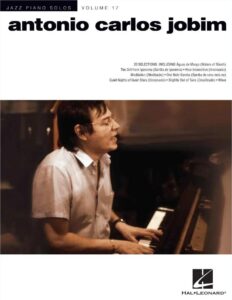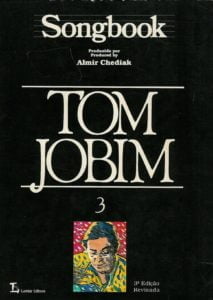Come join us now, and enjoy playing your beloved music and browse through great scores of every level and styles!
Can’t find the songbook you’re looking for? Please, email us at: sheetmusiclibrarypdf@gmail.com We’d like to help you!
Table of Contents
Tom Jobim
It has been said that Antonio Carlos Brasileiro de Almeida Jobim was the George Gershwin of Brazil—and there is a solid ring of truth in that, for both contributed large bodies of songs to the jazz repertoire, both expanded their reach into the concert hall, and both tend to symbolize their countries in the eyes of the rest of the world.
Best Sheet Music download from our Library.
With their gracefully urbane, sensuously aching melodies and harmonies, Tom Jobim’s songs gave jazz musicians in the 1960s a quiet, strikingly original alternative to their traditional Tin Pan Alley source.
Tom Jobim’s roots were always planted firmly in jazz; the records of Gerry Mulligan, Chet Baker, Barney Kessel and other West Coast jazz musicians made an enormous impact upon him in the 1950s. But he also claimed that the French impressionist composer Claude Debussy had a decisive influence upon his harmonies, and the Brazilian samba gave his music a uniquely exotic rhythmic underpinning.

As a pianist, he usually kept things simple and melodically to the point with a touch that reminds some of Claude Thornhill, but some of his records show that he could also stretch out when given room. His guitar was limited mostly to gentle strumming of the syncopated rhythms, and he sang in a modest, slightly hoarse yet often hauntingly emotional manner.
Please, subscribe to our Library.
If you are already a subscriber, please, check our NEW SCORES’ page every month for new sheet music. THANK YOU!
Born in the Tijuca neighborhood of Rio, Tom Jobim originally was headed for a career as an architect. Yet by the time he turned 20, the lure of music was too powerful, and so he started playing piano in nightclubs and working in recording studios.
He made his first record in 1954 backing singer Bill Farr as the leader of “Tom and His Band” (Tom was Jobim’s lifelong nickname), and he first found fame in 1956 when he teamed up with poet Vinicius de Morales to provide part of the score for a play called Orfeo do Carnaval (later made into the famous film Black Orpheus).

In 1958, the then-unknown Brazilian singer Joao Gilberto recorded some of Jobim’s songs, which had the effect of launching the phenomenon known as bossa nova.
Jobim’s breakthrough outside Brazil occurred in 1962 when Stan Getz and Charlie Byrd scored a surprise hit with his tune “Desafinado”—and later that year, he and several other Brazilian musicians were invited to participate in a Carnegie Hall showcase.
Fueled by Tom Jobim’s songs, the bossa nova became an international fad, and jazz musicians jumped on the bandwagon, recording album after album of bossa novas until the trend ran out of commercial steam in the late ’60s.
Jobim himself preferred the recording studios to touring, making several lovely albums of his music as a pianist, guitarist and singer for Verve, Warner Bros., Discovery, A&M, CTI and MCA in the ’60s and ’70s, and Verve again in the last decade of his life. Early on, he started collaborating with arranger/conductor Claus Ogerman, whose subtle, caressing, occasionally moody charts gave his records a haunting ambiance.
When Brazilian music was in its American eclipse after the ’60s, a victim of overexposure and the burgeoning rock revolution, Jobim retreated more into the background, concentrating much energy upon film and TV scores in Brazil. But by 1985, as the idea of world music and a second Brazilian wave gathered steam, Jobim started touring again with a group containing his second wife Ana Lontra, his son Paulo, daughter Elizabeth and various musician friends.
At the time of his final concerts in Brazil in September 1993 and at Carnegie Hall in April 1994 (both available on Verve), Jobim at last was receiving the universal recognition he deserved, and a plethora of tribute albums and concerts followed in the wake of his sudden death in New York City of heart failure. Jobim’s reputation as one of the great songwriters of the century is now secure, nowhere more so than on the jazz scene where every other set seems to contain at least one bossa nova.
Composer Antonio Carlos Jobim AKA Tom Jobim was born on January 25, 1927 in Tijuca, Rio de Janeiro, Brazil. He showed a natural curiosity towards music early on and at age 13 discovered an old piano in his parents’ school and started experimenting with sounds and notes.
Although he took some private piano lessons he was for the most part self-taught. At age 20 he gave up on his original plans to become an architect and devoted himself completely to music.
He started his career in 1952 playing piano in small cafes around the city. His early musical influences included the legendary composer Pixinguinha, Claude Debussy and jazz. In 1954 he cut his first record with his band called “Tom and His Band” backing the singer Bill Farr.
The same year he apprenticed to arranger Radames Gnatali from whom he learned the rudiments of arranging and shifted careers and for a while and became an arranger for local singers. In 1956 he collaborated with poet and diplomat Vinicius de Moraes on an operetta entitled Orfeo do Carnaval that opened to great acclaim at the Metropolitan Opera House in Rio.
The French director Marcel Camus transferred it to the big screen under the title Black Orpheus. The film was honored by the Cannes Film Festival with a Palme D’Or in 1959. His first hit was Felicidade from this operetta. The song gained immense popularity when Billy Eckstine added English lyrics to it in the late 1950s. Moraes and Jobim also teamed up on other hits including Girl from Ipanema and Agua de Beber among others.
In 1958 Brazilian guitarist and vocalist Joao Gilberto released a record of Jobim songs that marked the beginning of the bossa nova phenomenon.
1962 marked an important change in Jobim’s career when he broke out into the world scene after Stan Getz popularized his tune “Desafinado”. He and his colleagues were invited to perform at Carnegie Hall and the popularity of the bossa nova took off.
From 1962 till the end of the 60s, some jazz musicians recorded multitude of bossa nova albums. Jobim himself, in addition to becoming one of the most recorded composers, cut several albums for a variety of labels, often in collaboration with Claus Ogerman. The 1970s and 80s marked a time of low popularity for jazz and for Brazilian music due to the rock explosion.
Jobim returned to Brazil and worked on TV and film scores. By 1985 though bossa nova and Brazilian music experienced a renaissance and Jobim started touring again performing up to few months before his death in New York City of heart failure on December 8, 1994.
Download Jobim’s complete sheet music from our Library.
Browse in the Library:
Or browse in the categories menus & download the Library Catalog PDF:
Tom Jobim Live Concert 1986, Festival International de Jazz de Montréal, Canada (Ao vivo em Montreal)
Track List:
4:06 Água de Beber 7:34 Chega de Saudade 11:40 Two Kites 16:27 Wave (Instrumental) 19:26 Borzeguim 24:04 Falando de amor 27:22 Gabriela 36:27 A Felicidade 40:59 Samba do Avião 44:39 Waters of March 48:57 Girl from Ipanema/Garota de Ipanema 53:27 Canção do Exílio/Samba de Uma Nota Só

